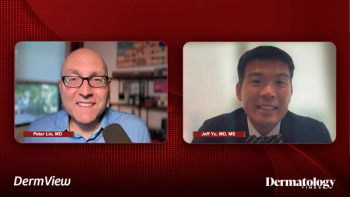
Vitiligo Treatment: Adverse Effects of Ruxolitinib
Experts review the main adverse effects of ruxolitinib, how to monitor for them in your practice, and the key takeaways for clinicians and payers to know about the 2 phase 3 trials that led to the approval of ruxolitinib in vitiligo.
Episodes in this series

Heather Woolery-Lloyd, MD: Let’s talk about some of the [adverse] effects of ruxolitinib. We’ve touched on this a little bit, but Renata, let’s talk about the main [adverse] effects of ruxolitinib, and how do you monitor for them in your practice?
Renata Block, PA-C: Basically, I make sure [patients] come back in about a month after the use of the drug. I think the most common can be the application site reactions such as pruritus or erythema. I haven’t experienced any of the other [adverse] effects that can happen, such as acne, headaches, or low-grade fevers, but I’d like to hear from [Dr Kindred] what her experience is with that. I’ll be honest with you, these [adverse] effects have been so minimal, and I think the benefit of what the patient is seeing as a reward of getting the pigmentation back is really driving them to continue to use it and not [experiencing] bothersome [adverse] effects at all.
Chesahna Kindred, MD, MBA, FAAD: I haven’t really seen [adverse] effects, not [from] the topical JAKs [Janus kinase inhibitors], and I prescribe a lot of orals. Listen, JAK-nee is real—that acne caused by JAK inhibitors. I thought I would see it with the topical for my patients who apply it to their face, but I haven’t. I haven’t seen it. These are motivated patients. For me, they really aren’t complaining about [adverse] effects, at least not voluntarily. This is one of those where it’s not at top of mind for patients.
Heather Woolery-Lloyd, MD:I agree. In my practice I have not seen a lot. I agree with you. I was expecting to see more acne on the face. I have not seen that, and I definitely haven’t seen folliculitis on the body. Again, JAK inhibitors are known historically to cause acne and folliculitis, but for some reason with the topical, I have not observed that yet in my practice, so I’ve been very fortunate, which in that it’s been very well tolerated in my practice, using topical ruxolitinib.
Chesahna Kindred, MD, MBA, FAAD: These vitiligo patients deserve a break.
Heather Woolery-Lloyd, MD:I know. It’s good that we have something, it’s effective, it doesn’t have a whole laundry list of things that we commonly see. I mean, we definitely know that there are things on that label, but in real-life practice, I haven’t seen any major issues with this new medication.
Renata Block, PA-C: Yeah, and I will ask them. A lot of times they won’t attribute the cause and effects. I will ask them [about] the typical [adverse] effects that can be seen. Like you, I don’t experience a lot of them. But if I ask them, “Did you get any acne to the site?” It’s like that aha moment. “Oh yeah, I did get a few pimples,” but again, with this specifically, not at all.
Heather Woolery-Lloyd, MD: Right. I think it’s good for us to ask specifics so we can really get a feel for it. But so far in my practice, I haven’t seen those [adverse] effects. Now let’s talk a little bit about long-term data. We know that there were 2 phase 3 trials that led to the approval of topical ruxolitinib in vitiligo, but we also have some long-term extension data available. [Dr Kindred], what were the key takeaways for clinicians and payers to know about the long-term data on this new medicine?
Chesahna Kindred, MD, MBA, FAAD: We read about the long-term data. We already know it works. But then the question is always, “What happens when I stop it? Do I have to stay on this, doctor?” What they showed is for the patients who stopped the medication—[patients who] were randomly withdrawn from the medication—they experienced a relapse of their vitiligo faster than the patients who stayed on the ruxolitinib. That answers 2 questions. It tells us that the patients can safely stay on the ruxolitinib. There [were] no new safety signals that occur when the patient stayed on the ruxolitinib. Interpret it as, this is a treatment and is prevention wrapped in one. [For] those who stopped it and relapsed, then the next question is, is it going to work if they resume it or not? They repigmented, and the median was about 12 weeks. We will have patients who want to stop it once they repigment, so let’s give them a chance to see, and we can tell them with some confidence, “Okay, if you lose progress, we’ll just start you back on it, and in about a few months we should start to see a response again.” Just to summarize, patients who stay on it are less likely to relapse; those who continue, we don’t see new safety signals; if they stopped, they could resume it.
Heather Woolery-Lloyd, MD: That’s a great summary, and I love that you said there [are] no new safety signals because for me, one of the most important things is safety. I think just as important as efficacy is safety. I love that the long-term data don’t have any new safety signals. That’s exciting for me just as a clinician who sees patients and uses ruxolitinib.
Transcript edited for clarity.
Newsletter
Like what you’re reading? Subscribe to Dermatology Times for weekly updates on therapies, innovations, and real-world practice tips.















